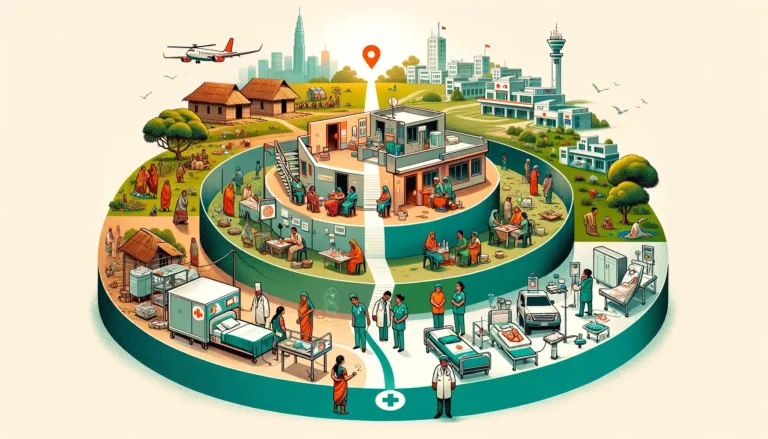Bangladesh’s healthcare system has evolved significantly over the years. Understanding its structure is crucial for comprehending the challenges and opportunities it faces. This guide provides an overview of the healthcare system’s evolution and the importance of its various levels.
- Bangladesh has primary, secondary, and tertiary levels of healthcare. [1]
- Here are some examples of healthcare facilities at each level:
-
- Primary: Upazila health complexes, union health and family welfare centers, and community clinics
- Secondary: District hospitals and maternal and child welfare centers
- Tertiary: Tertiary hospitals and diagnostic centers [2]
- Bangladesh’s healthcare system is pluralistic, with multiple providers using a mixed system of medical practices. The private sector dominates the healthcare industry, with a high growth in tertiary hospitals and diagnostic centers. [3]
- According to the WHO, Bangladesh ranks 88th in the world for healthcare quality. [4]
Primary Healthcare: The Foundation
Primary healthcare in Bangladesh serves as the frontline of the healthcare system, focusing on basic medical care and preventive services. Recent initiatives have seen improvements in primary healthcare services, especially in urban areas like Dhaka and Chattogram. These efforts are part of a larger project to establish a network of primary health centers offering a broad range of health, nutrition, and population services, with about 2.5 million children under 5 in urban areas receiving services. [5]
Secondary Healthcare: Bridging the Gap
Secondary healthcare involves more specialized services provided by district hospitals and specialized clinics. This level plays a crucial role in bridging the gap between primary care and more advanced medical services, offering both treatment and referral options for common and moderately complex health issues.
Tertiary Healthcare: Specialized and Advanced Care
Tertiary healthcare in Bangladesh is characterized by its advanced medical care and specialized treatments. Major hospitals in urban centers are equipped to provide specialized services, but there’s a need for improved patient flow and accessibility, especially for people in rural areas.
Quaternary Healthcare: Cutting-edge and Research
Though in its nascent stage, quaternary healthcare in Bangladesh is beginning to emerge, focusing on advanced medical science and research, such as in the field of cancer treatment.
Rural vs. Urban Healthcare Dynamics
The disparity between rural and urban healthcare availability and quality remains a significant challenge. Rural areas often lag in terms of access to comprehensive healthcare services compared to their urban counterparts.
Private Sector’s Role in Healthcare
The private sector in Bangladesh plays a critical role in the healthcare system, complementing the public sector. There has been a noticeable trend and growth in private healthcare services, offering an alternative to public health facilities.
Challenges in the Healthcare System
Despite reforms and advancements, the healthcare system in Bangladesh faces challenges like a shortage of formally qualified health professionals, low public financing, high out-of-pocket payments, and significant barriers to healthcare access. These issues impact the quality and accessibility of healthcare at all levels. [6]
Government Policies and Reforms
Recent health sector reforms have shifted from a project-based approach to a more integrated sector-wide approach. Initiatives like expanding community clinics and implementing voucher schemes have improved access, especially in rural districts. However, there’s still a need for greater emphasis on critical issues like human resources management and health financing.
The Role of International Aid and NGOs
International agencies like USAID play a significant role in supporting resilient health systems in Bangladesh. Their strategies focus on improving the health status of Bangladeshis by addressing weak areas in the health system and leveraging other funding sources. [7]
Future Outlook and Innovations
The future of healthcare in Bangladesh includes a focus on emerging trends and innovations. There’s potential for significant improvements at each level of care, with an emphasis on addressing existing challenges and leveraging technological advancements.
Conclusion
The healthcare system in Bangladesh, with its various levels, faces numerous challenges but also holds significant potential for improvement. Understanding each level’s role and challenges is key to navigating and improving the overall health landscape.
References and Further Reading
For more detailed information, readers are encouraged to explore academic, governmental, and NGO sources that provide in-depth analysis and data on the healthcare system in Bangladesh.
- HB2012_CH5_Senondary-tertiary-HCare.pdf
- Health in Bangladesh
- Healthcare Snapshot
- Five decades of growth in the healthcare system
- World Bank Helps Bangladesh Improve Primary Healthcare in Cities
- Health Systems Reforms in Bangladesh: An Analysis of the Last Three Decades
- USAID Bangladesh Health Strategy 2022-2027


